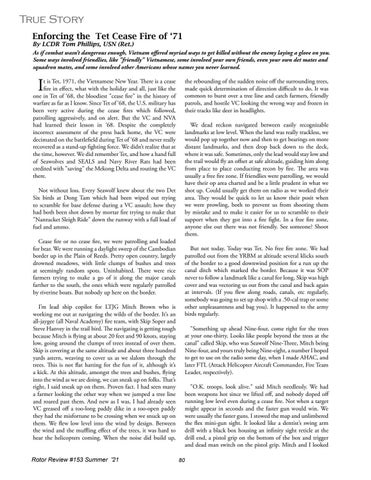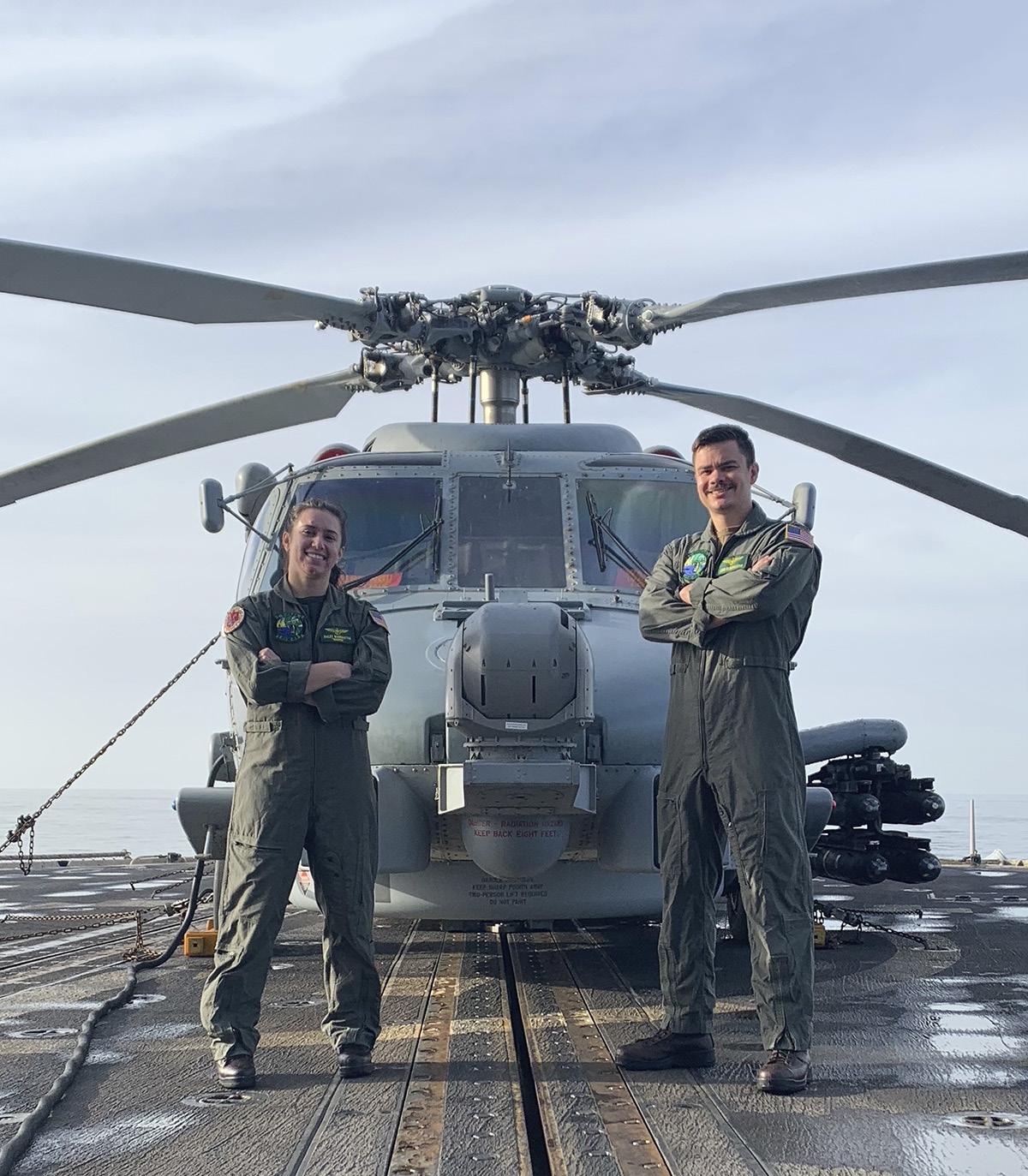True Story Enforcing the Tet Cease Fire of ‘71
By LCDR Tom Phillips, USN (Ret.) As if combat wasn’t dangerous enough, Vietnam offered myriad ways to get killed without the enemy laying a glove on you. Some ways involved friendlies, like "friendly" Vietnamese, some involved your own friends, even your own det mates and squadron mates, and some involved other Americans whose names you never learned.
I
t is Tet, 1971, the Vietnamese New Year. There is a cease fire in effect, what with the holiday and all, just like the one in Tet of ‘68, the bloodiest "cease fire" in the history of warfare as far as I know. Since Tet of ‘68, the U.S. military has been very active during the cease fires which followed, patrolling aggressively, and on alert. But the VC and NVA had learned their lesson in ‘68. Despite the completely incorrect assessment of the press back home, the VC were decimated on the battlefield during Tet of ‘68 and never really recovered as a stand-up fighting force. We didn’t realize that at the time, however. We did remember Tet, and how a hand full of Seawolves and SEALS and Navy River Rats had been credited with "saving" the Mekong Delta and routing the VC there. Not without loss. Every Seawolf knew about the two Det Six birds at Dong Tam which had been wiped out trying to scramble for base defense during a VC assault; how they had both been shot down by mortar fire trying to make that "Nantucket Sleigh Ride" down the runway with a full load of fuel and ammo. Cease fire or no cease fire, we were patrolling and loaded for bear. We were running a daylight sweep of the Cambodian border up in the Plain of Reeds. Pretty open country, largely drowned meadows, with little clumps of bushes and trees at seemingly random spots. Uninhabited. There were rice farmers trying to make a go of it along the major canals farther to the south, the ones which were regularly patrolled by riverine boats. But nobody up here on the border. I’m lead ship copilot for LTJG Mitch Brown who is working me out at navigating the wilds of the border. It’s an all-jaygee (all Naval Academy) fire team, with Skip Soper and Steve Hanvey in the trail bird. The navigating is getting tough because Mitch is flying at about 20 feet and 90 knots, staying low, going around the clumps of trees instead of over them. Skip is covering at the same altitude and about three hundred yards astern, weaving to cover us as we slalom through the trees. This is not flat hatting for the fun of it, although it’s a kick. At this altitude, amongst the trees and bushes, flying into the wind as we are doing, we can sneak up on folks. That’s right, I said sneak up on them. Proven fact. I had seen many a farmer looking the other way when we jumped a tree line and roared past them. And new as I was, I had already seen VC greased off a too-long paddy dike in a too-open paddy they had the misfortune to be crossing when we snuck up on them. We flew low level into the wind by design. Between the wind and the muffling effect of the trees, it was hard to hear the helicopters coming. When the noise did build up, Rotor Review #153 Summer '21
the rebounding of the sudden noise off the surrounding trees, made quick determination of direction difficult to do. It was common to burst over a tree line and catch farmers, friendly patrols, and hostile VC looking the wrong way and frozen in their tracks like deer in headlights. We dead reckon navigated between easily recognizable landmarks at low level. When the land was really trackless, we would pop up together now and then to get bearings on more distant landmarks, and then drop back down to the deck, where it was safe. Sometimes, only the lead would stay low and the trail would fly an offset at safe altitude, guiding him along from place to place conducting recon by fire. The area was usually a free fire zone. If friendlies were patrolling, we would have their op area charted and be a little prudent in what we shot up. Could usually get them on radio as we worked their area. They would be quick to let us know their posit when we were prowling, both to prevent us from shooting them by mistake and to make it easier for us to scramble to their support when they got into a fire fight. In a free fire zone, anyone else out there was not friendly. See someone? Shoot them. But not today. Today was Tet. No free fire zone. We had patrolled out from the YRBM at altitude several klicks south of the border to a good downwind position for a run up the canal ditch which marked the border. Because it was SOP never to follow a landmark like a canal for long, Skip was high cover and was vectoring us out from the canal and back again at intervals. (If you flew along roads, canals, etc regularly, somebody was going to set up shop with a .50-cal trap or some other unpleasantness and bag you). It happened to the army birds regularly. "Something up ahead Nine-four, come right for the trees at your one-thirty. Looks like people beyond the trees at the canal" called Skip, who was Seawolf Nine-Three, Mitch being Nine-four, and yours truly being Nine-eight, a number I hoped to get to use on the radio some day, when I made AHAC, and later FTL (Attack Helicopter Aircraft Commander, Fire Team Leader, respectively). "O.K. troops, look alive." said Mitch needlessly. We had been weapons hot since we lifted off, and nobody doped off running low level even during a cease fire. Not when a target might appear in seconds and the faster gun would win. We were usually the faster guns. I stowed the map and unlimbered the flex mini-gun sight. It looked like a dentist’s swing arm drill with a black box housing an infinity sight reticle at the drill end, a pistol grip on the bottom of the box and trigger and dead man switch on the pistol grip. Mitch and I looked 80









































